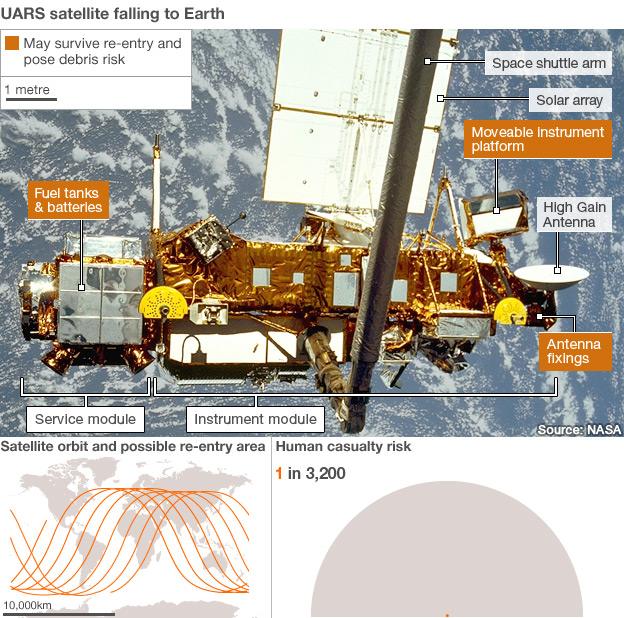Nasa refines satellite crash time
- Published

The "productive scientific life" of UARS ended in 2005 when it ran out of fuel
The US space agency (Nasa) says that its out-of-control climate satellite is expected to crash to Earth sometime on Friday evening (GMT).
There is still much uncertainty over when and where the satellite will re-enter the atmosphere.
Experts say they will get a more precise idea in the last 12 hours before the satellite is due to return.
The US space agency says the risk to life from the Upper Atmosphere Research Satellite, external (UARS) is 1 in 3,200.
Satellite and space expert Dr Stuart Eves stressed the large uncertainties involved in tracking the "decay" of satellite orbits (their slow fall back into the Earth's atmosphere).
Using the most recent determination of UARS' orbit - taken in the early hours of this morning - Dr Eves and a colleague have come up with their own projections of the satellite's final descent. But he explained that a spacecraft's orbit lifetime could only be estimated to about 10% accuracy.
This translates to a six-hour window either side of the expected decay which is based on a range of probabilities. Calculations using the data available on Thursday afternoon suggested a splash down in the Southern Ocean. But this is likely to change as tracking specialists get a better fix closer to Friday evening.
Given the 10% accuracy figure, and the fact that UARS takes about one-and-a-half hours to complete an orbit of Earth, the satellite could come down during one of four possible orbits of Earth on Friday evening/Saturday morning.
And a number of different estimates could be produced depending what software is used to model the satellite's decay, explained Dr Eves, who is lead mission concept engineer at Surrey Satellite Technology Limited (SSTL).
Thierry Legault's video of the UARS climate satellite falling
Satellite decays can be affected by a number of different factors, such as the shape of the spacecraft and its unpredictable tumbling, as well as heating of the Earth's atmosphere by ultraviolet radiation from the Sun.
This can make the atmosphere expand, causing UARS to fall to Earth faster than expected.
But other conditions could see the satellite stay in space for longer than anticipated.
Nasa says that debris could fall across an area 400-500km (250-310 miles) long.
In its latest update, the space agency said only that the spacecraft would "not be passing over North America" when it is expected to be pulled through the atmosphere to Earth.
The spacecraft could pass over Britain during its final passes over the planet.
Given that some 70% of the Earth's surface is covered by water, a splash-down for the debris seems most likely. But there remains a real possibility that some debris could fall on land.
UARS could land anywhere between 57 degrees north and 57 degrees south of the equator - most of the populated world.
The 1 in 3,200 risk to public safety is higher than the 1 in 10,000 limit that Nasa aims for.
But agency officials stress that nobody has ever been hurt by objects re-entering from space. And Dr Eves points out that meteorites are falling to Earth all the time.
The UARS satellite was deployed in 1991 from the space shuttle Discovery on a mission to study the make-up of Earth's atmosphere, particularly its protective ozone layer.
Nasa has warned members of the public not to touch any pieces of the spacecraft which may survive the re-entry, urging them to contact local law enforcement authorities.

Uars orbits the Earth between 57 degrees North and South
Nasa calculates some 26 components may survive the fall to Earth
The largest is a moveable instrument platform weighing almost 160kg
In total, about half a tonne may make it all the way to the surface
Paul.Rincon-INTERNET@bbc.co.uk
- Published21 September 2011
- Published16 September 2011
- Published19 June 2011